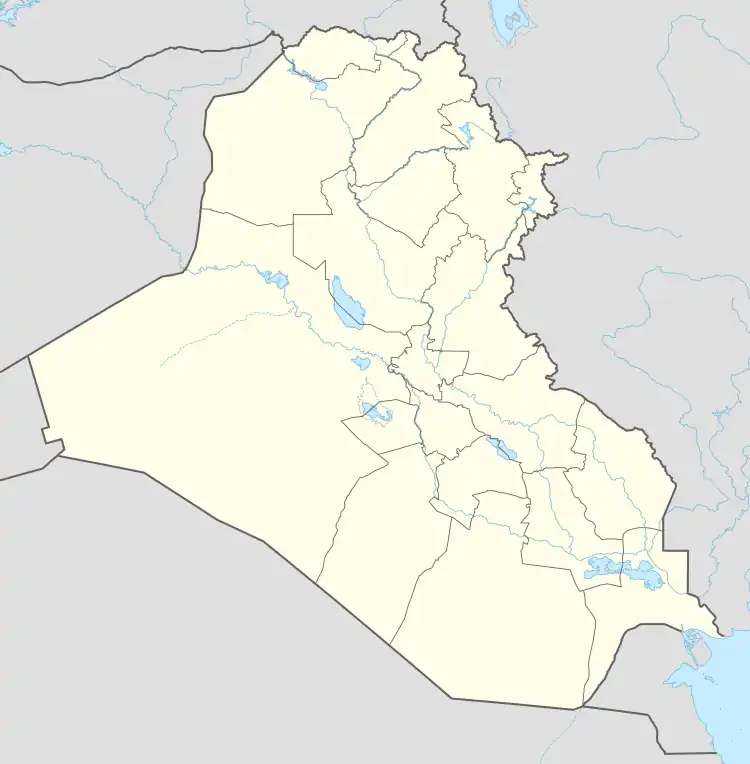Sadiyah
Sadiyah (Arabic: السعدية, romanized: Al-Sadiyah;[2] Kurdish: سەعدیە, romanized: Sedîye[3][4]) is a town in Diyala Governorate, Iraq. It is located near the Diyala River 8 km (5 mi) south of Jalawla.[5] The town is populated by Arabs, Kurds and Turkmens. It is disputed[6] and experienced significant Arabization during the Saddam era.[7]
Sadiyah
Qesrabad | |
|---|---|
Town | |
 Sadiyah | |
| Coordinates: 34°11′26.0″N 45°07′14.8″E | |
| Country | |
| Governorate | Diyala |
| District | Khanaqin District |
| Population (2013)[1] | |
| • Total | 47,213 |
Sadiyah is controlled by Badr Organization.[8]
History
Sadiyah has been the center town of Sadiyah Sub-District since the Ottoman era.[9] Sadiyah was used as winter pasture by the Kurdish Kalhor and Sanjâbi tribes who would pay pasturage dues to the Ottomans.[10] As part of the revolt of 1920, Sadiyah fell on 14 August 1920 largely due to the work of the Kurdish Dilo tribe.[11]
Kurds constituted 50% of the town in the 1947 census[12] and 40.5% in 1957.[9] Arabs constituted 47.1% of the population in 1957, while Iraqi Turkmens were 12.4%.[9] In the 1965 census, Arabs were the majority with 58.4% while Kurds constituted 24.7% and Turkmens were 9.6%.[13] In the 1977 census, the Arab population increased to 90.2%, while Kurds and Turkmens were 5.1% and 4% respectively.[14] In 1987, Arabs were 87.8% of the population, Kurds were 16.8% and Turkmens were 5.4%,[15] while the numbers were 83.1%, 9.9% and 7% for Arabs, Kurds and Turkmens, respectively in 1997.[16] More recent estimates state that Kurds constituted 38% in 2003 and 12% in 2012.[17]
After the fall of Saddam Hussein in 2003, Kurdistan Region pressured Arab settlers in Khanaqin to settle in Sadiyah which increased the Arab population further.[7] Peshmerga was deployed to the town in 2011 after request from the federal government in Baghdad to counter the attacks on the local Kurds.[18] The dire security after the overthrow of Saddam Hussein in 2003, forced more Kurds to leave the town.[19][7]
ISIS and aftermath
In the early hours of 13 June, ISIS seized Sadiyah, after Iraqi security forces had abandoned their posts. Several villages around the Hamrin Mountains were also captured.[20][21] Sadiyah was captured by the Popular Mobilization Forces in November 2014.[22] As of 2018, 80% of the Kurdish population have not returned to the town.[23]
References
- "Where are Iraq's Poor: Mapping Poverty in Iraq" (PDF). p. 77. Retrieved 21 October 2020.
- "عودة ٨٠٠ عائله نازحة الى منازلهم في ناحية السعدية بمحافظة ديالى". Rûdaw (in Arabic). 3 December 2019. Retrieved 20 December 2019.
- "Cejna berxwedana Kobanê pîroz be". Yeni Özgür Politika (in Kurdish). 29 July 2014. Retrieved 20 December 2019.
- "سەعدیە.. داعش هێرشی کردە سەر لیوایەکی حەشدی شەعبی" (in Kurdish). Retrieved 20 December 2019.
- "Jalula's Map". Map Landia. Retrieved 26 August 2014.
- Kane, Sean. "An Iraqi flashpoint loses its American safety net". Foreign Policy. Retrieved 20 December 2019.
- "Reviving UN Mediation on Iraq's Disputed Internal Boundaries". International Crisis Group. 14 December 2008. Retrieved 20 October 2020.
- Skelton, Mac; Saleem, Zmkan Ali (2019). "Iraq's disputed internal boundaries after ISIS: heterogeneous actors vying for influence" (PDF). Middle East Centre: 14–5.
- Ihsan, Mohammad, Administrative Changes in Kirkuk and Disputed Areas in Iraq 1968-2003, p. 44
- Ateş, Sabri (2013). Ottoman-Iranian Borderlands: Making a Boundary, 1843–1914. Cambridge University Press. p. 162. ISBN 9781107245082.
- Ireland, Philip Willard (1937). Iraq - A study in political development.
- C. J. Edmonds (1957). Kurds, Turks and Arabs, Politics, Travel and Research in North-Eastern Iraq, 1919-1925. Oxford University Press. p. 438. Retrieved 17 November 2019.
- Ihsan, Mohammad, Administrative Changes in Kirkuk and Disputed Areas in Iraq 1968-2003, p. 46
- Ihsan, Mohammad, Administrative Changes in Kirkuk and Disputed Areas in Iraq 1968-2003, p. 47
- Ihsan, Mohammad, Administrative Changes in Kirkuk and Disputed Areas in Iraq 1968-2003, p. 48
- Ihsan, Mohammad, Administrative Changes in Kirkuk and Disputed Areas in Iraq 1968-2003, p. 49
- "Iraqi Kurdistan: Paying A Heavy Price Over Identity". UNPO. 9 July 2012. Retrieved 21 October 2020.
- "Kurdish troops on patrol in Iraq's restive Diyala". Reuters. 9 September 2011. Retrieved 21 October 2020.
- "Iraq: The impending withdrawal of US troops revives Kurdo-Arab tensions". Kurdish Institute of Paris. August 2011. Retrieved 21 October 2020.
- Insurgents take two more Iraqi towns, Obama threatens air strikes Archived 13 June 2014 at the Wayback Machine
- "Iraq conflict: ISIS militants seize new towns". BBC. 13 June 2014. Retrieved 27 June 2014.
- "Shiite militias staying in 'disputed territories' could cause problems: officials". Rûdaw. 15 December 2014. Retrieved 21 October 2020.
- "Northern Iraq". Ministry of Immigration and Integration of Denmark. p. 72. Retrieved 21 October 2020.